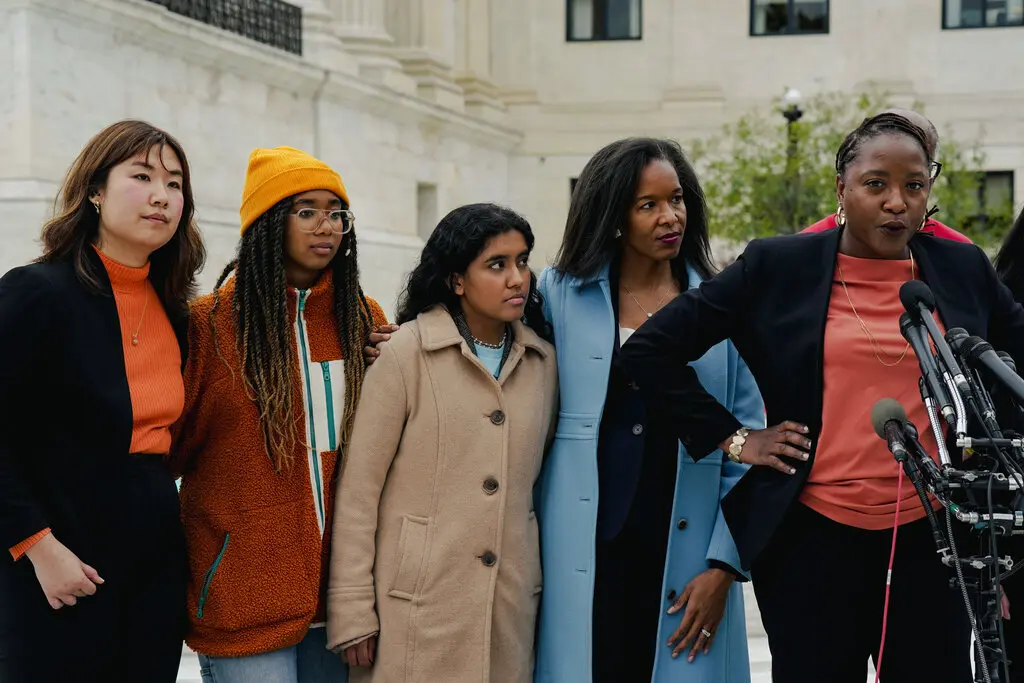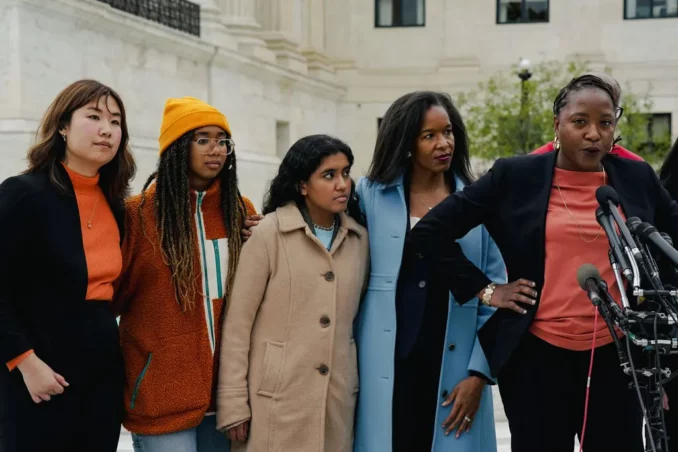

Black and Asian activists support affirmative action in Washington, D.C., during Oct. 31 oral arguments before the U.S. Supreme Court.
The Supreme Court of the United States is scheduled to rule sometime in 2023 on two cases threatening the very existence of affirmative action in higher education. Oral arguments were held before the top court on Oct. 31 in both of these cases that stem from “race-based” admissions at Harvard University and the University of North Carolina. The cases, both initiated by Students for Fair Admissions, claim that quotas set aside especially for Black and Latinx applicants unconstitutionally discriminate against white and Asian students.


Black and Asian activists support affirmative action in Washington, D.C., during Oct. 31 oral arguments before the U.S. Supreme Court.
If SCOTUS were to rule in favor of the plaintiffs in these two cases, it would endanger the right of oppressed students to access education at privileged colleges and universities throughout the country. It could have a similar political impact as the overturn of Roe v. Wade — the denying of the right to access abortion on a federal level — had in June. Not since the historic anti-Bakke decision in 1978 has affirmative action been in so much peril.
Allan Bakke, a 34-year-old white engineer, twice applied to medical school at the University of California at Davis. He was rejected both times. The medical school had only 100 openings each year, yet in 1972 there were more than 3,700 applicants. The special admissions program reserved 16 of its openings for students of “disadvantaged” backgrounds. These special admission slots had been filled each year by people of color.
Bakke filed suit against the university, charging “reverse discrimination.” The California Supreme Court ruled in favor of Bakke, saying it was unconstitutional to favor students of color, and that special admissions programs which consider race a factor do represent “reverse discrimination.”
SCOTUS, despite being dominated by Republican appointees, overturned the California Supreme Court ruling on June 28, 1978, in a 5-4 decision upholding the right to quotas in colleges and hiring practices. Behind this historic anti-racist decision was a mass mobilization two months prior of 35,000 mainly Black students in the streets of Washington, D.C., on April 15, 1978, to say no to racism.
A year later in 1979, SCOTUS ruled 5-2 in favor of an affirmative action program established by the United Steelworkers with a 50% quota for Black workers in Kaiser Aluminum’s skilled-craft program. Brian Weber, a white steelworker, sued the USW, charging “reverse discrimination.” Black workers had been systematically discriminated against in whites-only, union skilled-craft jobs.
The 1978 Bakke decision was legally based on the unanimous SCOTUS 1954 ruling in Brown v. the Board of Education that outlawed segregated public schools because they denied Black students equal protection under the 14th Amendment.
The 1979 Weber decision was based on Title VII of the 1964 Civil Rights Act, which prohibits discrimination in virtually every employment circumstance on the basis of race.
The erosion of affirmative action
There have been many legal challenges to affirmative action on a local and statewide basis over the past decades since 1979 under various U.S. administrations. None of these cases should be viewed in isolation.
Affirmative action is not about charity, nor is it a moral question. First, it is a recognition that racism and national oppression, which victimize people of color, permeate every aspect of the capitalist system in the areas of jobs, education, health care, housing and more. Second, quotas are one necessary remedy to provide for those who have been historically locked out of opportunities due to white supremacy, but in a limited way.
White supremacy is rooted in the legacy of the brutal theft of Indigenous lands, the enslavement of African peoples and oppression of Latinx people — who, along with many Indigenous nations such as the Puebloan nations, lost a large part of Mexico, now known as the U.S. Southwest, in a bloody, genocidal war with the U.S. in 1848.
The massive Civil Rights struggles in the South and righteous rebellions of Black people against poverty and unemployment in the Northern urban areas, and especially on the West Coast in 1965 in the Los Angeles Watts section, forced the U.S. government to give more than just lip service to the idea of affirmative action.
It was the Nixon administration in 1969 that established the Office of Federal Contract Compliance, in consultation with Philadelphia contractors, that was authorized to establish numerical ranges for hiring African Americans. For instance, contractors were to hire 5% to 9% Black ironworkers, with additional increases each year after 1970 — until Nixon quickly backtracked on this policy.
Solidarity is key
The Committee of 100, a Chinese American group, issued an Oct. 31 statement in defense of affirmative action, stating in part: “We must not allow the current litigation before the Court to drive apart the Chinese American or broader minority communities. We must stand with each other as we have on issues such as anti-Asian hate and violence.
“While we acknowledge the genuine angst and concerns of many Chinese American students and parents, who pursue educational opportunities as their pathway to realizing the American dream, race-conscious admissions policies make it possible for students of all backgrounds, including poor and disadvantaged students from the Chinese American community, to access higher education and ultimately contribute to a stronger, more diverse and more inclusive union.”
The forces that will profit from the total decimation of affirmative action will be the racist billionaire bosses and their puppet politicians, who will use every dirty scheme in the book to divide the multinational working class to maintain capitalist class rule.
In light of the growing global economic crisis that is causing so much pain, suffering and uncertainty for billions of people, international solidarity is key to defending affirmative action and other programs won through mass struggle.
As a key organizer of the April 15 March in Washington, now Workers World Party First Secretary, Larry Holmes stated at a New York City meeting in 1978: “What is so significant is that this anti-Bakke march has inspired thousands all over the country and could possibly provide the energy for a rejuvenation of the anti-racist and anti-imperialist movement.” (WW, April 14, 1978)
Fast forward 44 years later, his words are just as profound now as ever, in terms of uniting and fighting to not only defend but expand affirmative action.
Hamas issued the following statement on April 24, 2025, published on Resistance News Network. The…
By D. Musa Springer This statement is from Hood Communist editor and organizer D. Musa…
Portland, Oregon On April 12 — following protests in Seattle and elsewhere in support of…
This statement was recently issued by over 30 groups. On Friday, March 28, Dr. Helyeh…
When Donald Trump announced massive tariffs on foreign imports April 2, Wall Street investors saw…
The century-long struggle to abolish the death penalty in the U.S. has been making significant…